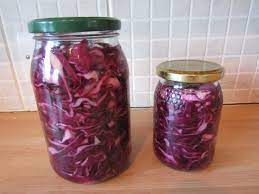
Firstly, introducing Auscrops, a wonderful market vending company bridging farmers and customers together through market vendors. Click here to find out more about How to Pickle Cabbage as well fruit and vegetable offers.
How to Pickle Cabbage – Step by Step
Are you a fan of sauerkraut, kimchi, or other pickled vegetables? If so, have you ever tried pickling your own cabbage? Pickling cabbage is a popular preservation method that not only extends the shelf life of this nutritious vegetable but also gives it a distinct tangy flavor and crunchy texture. In this article, we will guide you through the process of pickling cabbage at home. Whether you want to add it to your sandwiches, salads, or stir-fries, pickled cabbage is a great addition to any meal.
Step 1: Gather Your Ingredients
To pickle cabbage, you will need the following ingredients:
- One head of cabbage
- Coarse salt (such as kosher or sea salt)
- Water
- Vinegar (such as apple cider, white, or rice vinegar)
- Sugar
- Spices (optional)
Step 2: Prepare the Cabbage
Start by removing any outer leaves that are wilted or discolored. Cut the cabbage in half and remove the core. Then, slice the cabbage into thin strips (about 1/4 inch thick). Wash the cabbage strips thoroughly in cold water and drain them.
Step 3: Salt the Cabbage
Place the cabbage strips in a large bowl and sprinkle a generous amount of salt over them (about 1 tablespoon per pound of cabbage). Use your hands to massage the salt into the cabbage until it starts to release its juices. This process, known as osmosis, will help draw out the excess water from the cabbage and create a brine.
Step 4: Add the Flavorings
If you want to add some spices or herbs to your pickled cabbage, now is the time to do it. Popular choices include garlic, ginger, chili flakes, dill, or caraway seeds. Mix the spices with the cabbage and toss them well.
Step 5: Let it Sit
Transfer the cabbage and its juice into a clean glass jar or crock. Make sure the container is large enough to hold the cabbage and still leave room for the brine to cover it. Use a weight or a plate to keep the cabbage submerged in the brine. Cover the container with a clean kitchen towel or cheesecloth and secure it with a rubber band. Let the cabbage sit at room temperature for 1-2 days, stirring it occasionally.
Step 6: Make the Pickling Liquid
After the cabbage has started to ferment, it’s time to make the pickling liquid. In a medium saucepan, mix equal parts of vinegar and water (such as 1 cup each). Add sugar according to your taste (usually 1-2 tablespoons per cup of liquid) and bring the mixture to a boil. Pour the hot liquid over the fermented cabbage, making sure it covers the cabbage completely.
Step 7: Store and Enjoy
Let the pickled cabbage cool to room temperature, then cover the container with a tight-fitting lid and store it in the refrigerator. The pickled cabbage will keep for several weeks or even months if stored properly. Enjoy it as a condiment, side dish, or snack.
Conclusion:
Pickling cabbage is a simple and rewarding process that anyone can do at home. Whether you prefer a mild or a spicy flavor, there are endless possibilities to customize your pickled cabbage with your favorite spices and herbs. Not only is pickled cabbage a delicious and crunchy addition to your meals, but it also provides a range of health benefits, such as aiding digestion, boosting immune function, and reducing inflammation.
Click here to read similar articles.
 Français
Français 











